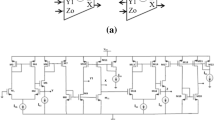Abstract
This paper originality is put forward a second-generation voltage conveyor (VCII) based voltage-mode PID controller. The proposed circuit includes a single VCII-, two capacitors, two resistors, and no need any passive component matching conditions. The sensitivity has been investigated for the control parameters. Besides, the impacts on operating frequency ranges of the parasitic impedances have been examined. Simulation outcomes have been obtained by operating TSMC 0.18 μm CMOS technology parameters with power supply ± 0.9 V. Additionally, a closed-loop control system application is included to demonstrate the circuit’s functioning. An experimental study is given to confirm the time-domain performance of the proposed circuit by using commercially available integrated circuits.

















Similar content being viewed by others
Data availability
The datasets generated during and/or analyzed during the current study are available from the corresponding author on reasonable request.
References
Erdal, C., Toker, A., & Acar, C. (2001). Ota-C based proportional-integral-derivative (PID) controller and calculating optimum parameter tolerances. Turkish Journal of Electrical Engineering and Computer Sciences, 9(2), 189–198.
Keskin, A. U. (2006). Design of a PID controller circuit employing CDBAs. International Journal of Electrical Engineering Education, 43(1), 48–56. https://doi.org/10.7227/IJEEE.43.1.5
Pandey, N., Kapur, S., Arora, P., & Sharma, S. (2011). MO-CCCCTA based PID controller employing grounded passive elements. 2011 2nd International Conference on Computer and Communication Technology, ICCCT-2011, pp 270–273.
Srisakultiew, S., & Siripruchyanun, M. (2013). A synthesis of electronically controllable current-mode PI, PD and PID controllers employing CCCDBAs. Circuits and Systems, 04(03), 287–292. https://doi.org/10.4236/cs.2013.43039
Ayten, U. E., Yuce, E., & Minaei, S. (2018). A voltage-mode PID controller using a single CFOA and only grounded capacitors. Microelectronics Journal, 81, 84–93. https://doi.org/10.1016/j.mejo.2018.09.010
Safari, L., Yuce, E., Minaei, S., Ferri, G., & Stornelli, V. (2020). A second-generation voltage conveyor (VCII)–based simulated grounded inductor. International Journal of Circuit Theory and Applications, 48(7), 1180–1193. https://doi.org/10.1002/cta.2770
Çam Taşkıran, Z. G., Sedef, H., & Anday, F. (2020). A new PID controller circuit design using CFOAs. Circuits, Systems, and Signal Processing. https://doi.org/10.1007/s00034-020-01540-5
Erdal, C., Kuntman, H. H., & Kalalı, S. (2004). A current controlled conveyor based proportional-integral-derivative (PID) controller. Istanbul University—Journal of Electrical and Electronics Engineering, 4(2), 1243–1248.
Yuce, E., Tokat, S., Kizilkaya, A., & Cicekoglu, O. (2006). CCII-based PID controllers employing grounded passive components. AEU—International Journal of Electronics and Communications, 60(5), 399–403. https://doi.org/10.1016/j.aeue.2005.03.017
Yuce, E., Tokat, S., Minaei, S., & Cicekoglu, O. (2006). Low-component-count insensitive current-mode and voltage-mode PID PI and PD controllers. Frequenz, 60(3–4), 65–69. https://doi.org/10.1109/ISIE.2005.1528911
Gupta, S. S., Bhaskar, D. R., Senani, R., & Singh, A. K. (2009). Inverse active filters employing CFOAs. Electrical Engineering, 91(1), 23–26. https://doi.org/10.1007/s00202-009-0112-3
Yuce, E., & Minaei, S. (2010). New CCII-based versatile structure for realizing PID controller and instrumentation amplifier. Microelectronics Journal, 41(5), 311–316. https://doi.org/10.1016/j.mejo.2010.03.008
Wang, H.-Y., Chang, S.-H., Yang, T.-Y., & Tsai, P.-Y. (2011). A novel multifunction CFOA-based inverse filter. Circuits and Systems, 02(01), 14–17. https://doi.org/10.4236/cs.2011.21003
Gupta, S. S., Bhaskar, D. R., & Senani, R. (2011). New analogue inverse filters realised with current feedback op-amps. International Journal of Electronics, 98(8), 1103–1113. https://doi.org/10.1080/00207217.2010.547812
Sagbas, M., Koksal, M., & Ayten, U. E. (2013). Design of dominantly proportional PID controller using a single commercially available active component. 2013 36th International Conference on Telecommunications and Signal Processing, TSP 2013, pp 427–430.
Silaruam, V., Lorsawatsiri, A., & Wongtaychatham, C. (2013). Novel resistorless mixed-mode PID controller with improved low-frequency performance. Radioengineering, 22(3), 932–940.
Tangsrirat, W. (2015). Voltage-mode analog PID controller using a single- z-copy current follower transconductance amplifier (ZC-CFTA). Informacije MIDEM, 45(3), 175–179.
Patil, V., & Sharma, R. K. (2015). Novel inverse active filters employing CFOAs. International Journal for Scientific Research & Development, 3(7), 359–360.
Pandey, R., Pandey, N., Chitranshi, S., & Paul, S. K. (2015). Operational transresistance amplifier based PID controller. Advances in Electrical and Electronic Engineering, 13(2), 171–181. https://doi.org/10.15598/aeee.v13i2.1164
Yuce, E., & Alpaslan, H. (2016). DDCC+ based voltage-mode PID controller employing only grounded passive components. Indian Journal of Engineering and Materials Sciences, 23(2–3), 120–128.
Singh, A. K., Gupta, A., & Senani, R. (2017). OTRA-based multi-function inverse filter configuration. Advances in Electrical and Electronic Engineering, 15(5), 846–856. https://doi.org/10.15598/aeee.v15i5.2572
Prommee, P., & Angkeaw, K. (2018). High performance electronically tunable log-domain current-mode PID controller. Microelectronics Journal, 72(July), 126–137. https://doi.org/10.1016/j.mejo.2017.09.008
Özer, E. (2021). Design of Voltage-Mode PID Controller Based on Current Follower Transconductance Amplifiers. In Global Conference on Engineering Research (GLOBCER’21) (pp. 165–178).
Özer, E., & Kaçar, F. (2021). Design of voltage-mode PID controller using a single voltage differencing current conveyor (VDCC). Analog Integrated Circuits and Signal Processing. https://doi.org/10.1007/s10470-021-01880-5
Funding
The author(s) received no specific funding for this work.
Author information
Authors and Affiliations
Corresponding author
Ethics declarations
Conflict of interest
The authors declared that there is no conflict of interest.
Additional information
Publisher's Note
Springer Nature remains neutral with regard to jurisdictional claims in published maps and institutional affiliations.
Rights and permissions
About this article
Cite this article
Özer, E., Sayın, A. & Kaçar, F. Voltage-mode PID controller design employing canonical number of active and passive elements. Analog Integr Circ Sig Process 113, 361–371 (2022). https://doi.org/10.1007/s10470-022-02057-4
Received:
Revised:
Accepted:
Published:
Issue Date:
DOI: https://doi.org/10.1007/s10470-022-02057-4




